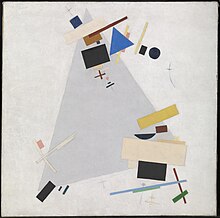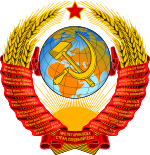User:Moo1122334455/sandbox
Cubo Futurism
[edit]
Cubo-Futurism (also called Russian Futurism or Kubo-Futurizm) was an art movement that arose in early 20th century Russia, defined by its amalgamation of the artistic elements found in Italian Futurism and French Analytical Cubism.[1]
In 1913, the term ‘Cubo-Futurism’ first came to describe works from members of the poetry group ‘Hylaeans,’ as they moved away from poetic Symbolism towards Futurism and zaum, the experimental “visual and sound poetry of Kruchenykh and Khlebninkov”.[2] Later in the same year the concept and style of ‘Cubo-Futurism’ became synonymous with the works of artists within Russian post-revolutionary avant-garde circles as they interrogated non-representational art through the fragmentation and displacement of traditional forms, lines, viewpoints, colours, and textures within their pieces.[3] The impact of Cubo-Futurism was then felt within performance art societies, with Cubo-Futurist painters and poets collaborating on theatre, cinema, and ballet pieces that aimed to break theatre conventions through the use of nonsensical zaum poetry, emphasis on improvisation, and the encouragement of audience participation (an example being the 1913 Futurist theatre tragedy Vladimir Mayakovsky).[4][5]
The coexistence of these differing strands of artistic practice within Cubo-Futurism reflects an ideological preoccupation with collective renewal and deconstruction (a notion born of their post-revolutionary context) with each poet or painter free to create their own aesthetic consciousness based on the concept of revolution and collective action through reinterpretation of artistic and social traditions.[6]
Founding of the Movement
[edit]Importance of Post-Revolutionary Context
[edit] |
| History of art |
| Art history |
In the context of late tsarist Russia, society was deeply divided by social class. Russian industrialisation, development, economic growth, and urbanisation fell far behind other Western nations, with the country experiencing high levels of illiteracy, poor health care, and struggling with the limitations of little mass communication outside larger cities.[7] Looking outward at the realities of those from neighbouring countries, artists who would later become members of the Cubo-Futurist movement noticed the impacts of the burgeoning Machine Age on everyday life, recognising the beauty, dynamism, and energy of the utilitarian machine aesthetic leading to a renewed interest in technological modernisation within art, poetry, and life.[8] Active in Russian art circles Ukrainian born Aleksandr Shevchenko (1883-1948) echoed this sentiment when, in 1913, he stated, “the world has been transformed into a single, monstrous, fantastic, perpetually-moving machine, into a single huge non-animal automatic organism… [this] cannot help but be reflected in our thinking and in our spiritual life: in Art”.[9] The “cult of the machine” became an increasingly utopic concept within Cubo-Futurist circles, with artists perceiving the idyllic phenomenon of machine production as the foremost “proletariat creation” due to its ability to help construct an equitable, collective life for all people regardless of class.[10][11] This ideological conception of utopic perfection through machinery significantly impacted the stylistic elements of the Cubo-Futurist movement, influencing artists to experiment with pure abstraction, geometric shapes, harsh lines and planes, and the deconstruction of organic forms into powerful structures infused with machine symbolism.[12]
Impact of Russian art Collectors
[edit]At the top of early 20th century Russia’s deep social, political, and class divisions were a small group of elite aristocrats and businessmen. With considerable access to international art markets and dealers, they assembled significant number European masterpieces of the early 20th century for their own personal collections. Collectors and patrons, Sergei Shchukin (1854-1936) and Ivan Morozov (1871-1921), paid special attention to Impressionist, Post-Impressionist, Fauvist, Cubist, and Futurist art from all over Europe amassing a large selection of momentous works, and consequently introducing local Russian artists to art movements, techniques, and styles popular around the continent.[13] Shchukin’s collection included a considerable number of Picassos, Matisses, Cezannes, Monets, and Gauguins, thus allowing artists in St. Petersburg and Moscow access to Cubist and Futurist artworks that would later influence the development of the Cubo-Futurist movement.[14]
Movement
[edit]Art
[edit]
For Cubo-Futurist artists, this movement represented a shift in stylistic values from a perception of painting as a reflection of their current reality into a portrayal of idealism through depictions of a perfect future defined by equality and an organised collective consciousness.[15] One such example would be Kazimir Malevich’s (1878-1935) 1912-13 The Knife Grinder (The Glittering Edge). The flickering of reflective metallic colours creates a dynamic representation of motion and energy, depicting the “mechanical vibration and dynamic rhythm” of modernisation through industrialisation and mechanical harmony.[16] The knife grinder himself is central to the composition, camouflaged within the dense abstracted geometric shapes that surround and encompass him, invoking the idea that the man has fused into the mechanical perfection of a giant organised system.[17] To Malevich and other artists of the Cubo-Futurist movement, works like this acted as a social metaphor highlighting the process of transformation, revolution, social rebuilding, and proletariat collectivism they wished to see in their society’s future.[18] Complex abstracted geometric shapes and representations of perfected mechanical society’s highlights the revolutionary nature of their work as, “only futurist art is constructed on collective principles… Only futurist art is, at the present time, ‘the art of the proletariat’” as painter and sculptor Nathan Altman (1889-1970) once stated.[19]
Effects of Cubo-Futurism
[edit]
Cubo-Futurism was incredibly significant in the development of art styles like Rayism, Supremitism, and Constructivism, with the movement acting as a transitionary phase between objective, figurative works and radical non-objective, non-representational abstract art.[20] Cubo-Futurism gave artists the freedom to engage with the limitations of representation and subjectivity, and experiment with use geometric shapes and fragmented forms in order to convey a movement and dynamism that reflected their attempts to reconstruct understandings of their world and their art. Cubo-Futurism acted as the jumping off point for artist Mikhail Larionov (1881-1964) to develop Rayism, one of the first non-objective Russian artistic styles, which then later influenced Kazimir Malevich to create Supremitism, an art mode that is now considered one of the most significant modern art movements of the 20th century.[21]
Overview of Russian History
[edit]| Part of a series on the |
| History of the Union of Soviet Socialist Republics |
|---|
 |
Wars in Africa
Olympic boycotts
|
| History of |
| Soviet leadership |
|
|
Helpful External links
[edit]- https://www.moma.org/learn/moma_learning/glossary/- Museum of Modern Art online dictionary of visual art terms.
- https://www.metmuseum.org/learn/educators/curriculum-resources - Metropolitan Museum of Art curriculum resources page
- https://www.moma.org/learn/moma_learning/ - free online resources engaging for modern and contemporary art
- https://www.moma.org/collection/terms/?=MOOC - glossary of significant art terms
- https://www.moma.org/research-and-learning/ - MOMA research and learning online page
- https://www.tate.org.uk/research/publications/tate-papers - Tate Modern London online journal of research papers and scholarly articles
- https://www.oxfordartonline.com/ - Oxford's collection of peer reviewed articles, important dictionary terms, and images
See also
[edit]Modern art (disambiguation) - list of articles associated with the title 'Modern art'
See Art periods for a chronological list.
Category:Art history templates
Category:Visual arts templates
Art movements Visual arts Visual arts 1 Category:Wikipedia missing topics
Category:Lists of visual art topics
References
[edit]- ^ Parton, Anthony (2016-05-09). "Cubo-Futurism". Routledge Encyclopedia of Modernism. Retrieved 2020-03-18.
{{cite web}}: CS1 maint: url-status (link) - ^ Gourianova, Nina (2012). "The Aesthetics of Anarchy". The Aesthetics of Anarchy: Art and Ideology in the Early Russian Avant-Garde. California: University of California Press. p. 17.
- ^ Douglas, Charlotte (1975). "The New Russian Art and Italian Futurism". Art Journal. 34, no.3: 229–239.
- ^ Sarabianov, Andrei (2019-12-06). "Cubo-Futurism: Art Movement". Britannica. Retrieved 2020-03-18.
{{cite web}}: CS1 maint: url-status (link) - ^ "Russian Futurism Movement Overview and Analysis". The Art Story. 2017. Retrieved 2020-03-18.
{{cite web}}: CS1 maint: url-status (link) - ^ Hughes, Robert (1980). "Faces of Power". The Shock of the New: Art and the Century of Change. London: British Broadcasting Company. p. 85.
- ^ Tian-Shanskaia, Olga (1993). "Introduction". Village Life in Late Tsarist Russia. Indiana: Indiana University Press. p. xi.
- ^ Kinchin, Juliet (2018). "The Machinery of the Modern World". MOMA at NGV: 130 Years of Contemporary Art. Melbourne: The Council of Trustees of the National Gallery of Victoria. p. 44.
- ^ Vaingurt, Julia (2013). Wonderlands of the Avant-Garde: Technology and the Arts in Russia of the 1920s. Illinois: Northwestern University Press. p. 241.
- ^ Hughes, Robert (1980). The Shock of the New: Art and the Century of Change. London: British Broadcasting Company. p. 85.
- ^ Gassner, Hubertus (1992). "The Constructivists: Modernism on the Way to Modernisation". The Great Utopia: The Russian and Soviet Avant-Garde 1915-1932. New York: Guggenheim Museum Publications. p. 298.
- ^ Sharp, Jane Ashton (1986). "A Westernising Avant-Garde". in Russian Modernism between East and West: Natalia Goncharova and the Moscow Avant-Garde. Cambridge: University of Cambridge Press. p. 61.
- ^ Hughes, Robert (1980). "Faces of Power". The Shock of the New: Art and the Century of Change. London: British Broadcasting Company. p. 81.
- ^ Robert, Hughes (1980). "Faces of Power". The Shock of the New: Art and the Century of Change. London: British Broadcasting Company. p. 81.
- ^ Stapanian, Juliette (1986). "Conclusion: From the Broken Frame toward the Opened Form". Mayakovsky’s Cubo-Futurist Vision. Texas: Rice University Press. p. 186.
- ^ McKiernan, Mike (2014). "Kazimir Malevich, The Knife Grinder (The Glittering Edge) 1912-13". Art and Occupation: Occupational Medicine. 64, no.5: 317–318.
- ^ McKiernan, Mike (2014). "Kazimir Malevich, The Knife Grinder (The Glittering Edge) 1912-13". Art and Occupation: Occupational Medicine. 64, no.5: 317–318.
- ^ Hughes, Robert (1980). "Faces of Power". The Shock of the New: Art and the Century of Change. London: British Broadcasting Company. p. 85.
- ^ Erjavec, Aleš (2015). Aesthetic Revolution and Twentieth-Century Avant-Garde Movements. North Carolina: Duke University Press. p. 102.
- ^ Barooshian, Vahan (1975). Russian Cubo-Futurism, 1910-1930. Berlin: De Gruyter Mouton. p. 146.
- ^ Kinchin, Juliet (2018). "A New Unity". MOMA at NGV: 130 Years of Contemporary Art. Melbourne: The Council of Trustees of the National Gallery of Victoria. p. 73.


